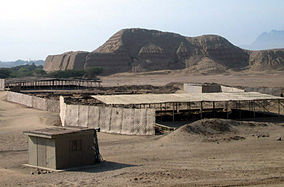Huaca del Sol
| Huaca del Sol | |
|---|---|
 Panoramic view of temple or Huaca of the Sun | |
| Location | |
| Nearest city | |
| Coordinates | 8°8′5.93″S 78°59′27.40″W / 8.1349806°S 78.9909444°W |
| Established | Mochica era |


The Huaca del Sol is an adobe brick temple built by the Moche civilization on the coast of what is now Peru. The temple is one of several ruins found near the peak of Cerro Blanco, in the coastal desert near Trujillo, Peru. The other major ruin at the site is the nearby Huaca de la Luna, a better-preserved but smaller temple.
By 450 CE, eight different stages of construction had been completed on the Huaca del Sol. The construction of the temple was additive; new layers of brick were laid directly on top of the old, hence large quantities of bricks were required for its construction. It has been estimated by archaeologists that the Huaca del Sol was composed of over 130 million adobe bricks and was the largest pre-Columbian adobe structure built in the Americas.[1] The number of different makers' marks on the bricks suggests that over a hundred different communities contributed bricks to the construction of the Huacas.
The Huaca del Sol was composed of four main levels and the structure was expanded and rebuilt by different rulers over the course of time. Located at the center of the Moche capital city, archaeological evidence suggests that this temple was used for ritual activity and as a royal residence and burial chambers.
During the Spanish occupation of Peru in the early 17th century, the waters of the Moche River were redirected to run past the base of the Huaca del Sol in order to facilitate the looting of gold artifacts from the temple. The creation of this hydraulic mine greatly damaged the Huaca del Sol, and it is estimated that approximately two-thirds of the structure has been lost to erosion and looting. The remaining structure stands at a height of 41 meters (135 feet). It is believed to have originally been about 50 meters in height. Looting and erosion due to El Niño continue to be major concerns to this day.
See also
External links
- www.huacas.com
- Sun and Moon Official Project information
- Huaca del Sol placemarks Google Earth .kmz
Notes
- ^ Cameron, Ian (1990). Kingdom of the Sun God: a history of the Andes and their people. New York: Facts on File. p. 43. ISBN 0-8160-2581-9.
References
- Art of the Andes, from Chavin to Inca. Rebecca Stone-Miller, Thames and Hudson, 1995.
- The Incas and Their Ancestors: the archaeology of Peru. Michael E. Moseley, Thames and Hudson, 1992.
